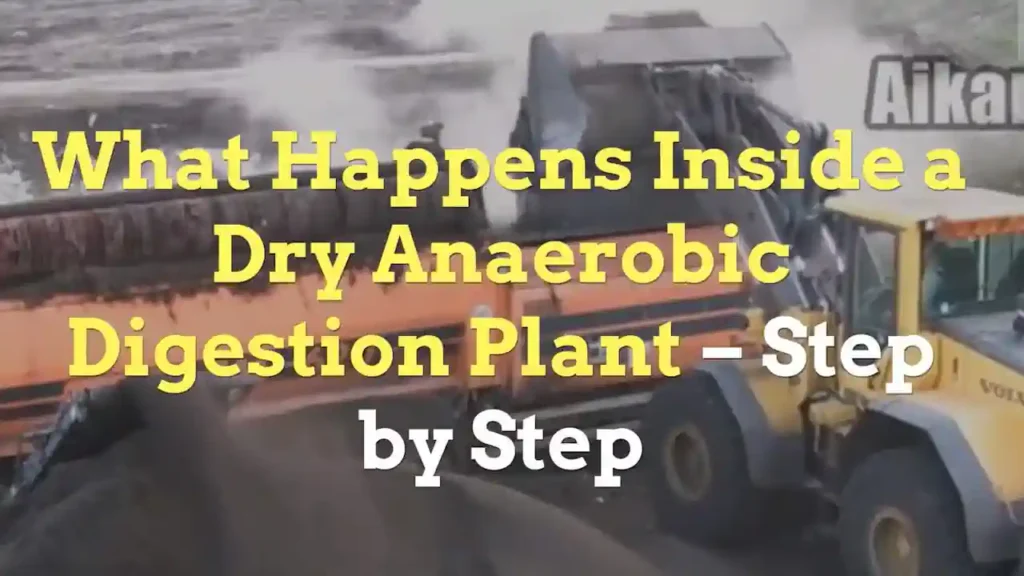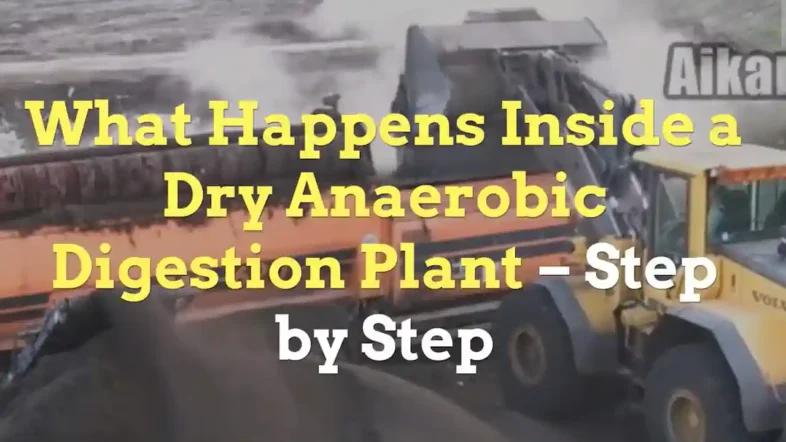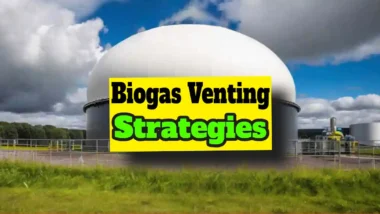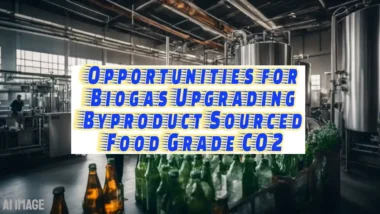The dry anaerobic digestion process (AD) is the anaerobic digestion of biomass in the solid phase.
The phase (i.e. liquid or solid) is the main distinction between “Dry Anaerobic Digestion” processes and “Wet Anaerobic Digestion” processes.
The waste industry refers to the “Dry Anaerobic Digestion Process” but the scientific community calls it SSAD (Solid State Anaerobic Digestion).
Dry and Wet Anaerobic Digestion Processes Compared and Contrasted
In Wet AD processes, the organic matter, whether a solid, such as a natural fibrous material, or a liquid, is digested as if it were a liquid (as a mixture, mash, or slurry).
In Dry AD processes, the substrate is moved through the process by mechanical handling (front-end shovels, etc.) in batches, whereas in Wet AD systems, the substrate (containing solid fibres and dissolved organic chemicals) is pumped. All common Wet AD processes are continuous, in contrast to Dry AD are not normally batch processes.
Th e exception to this is the Dry AD processes, which are generally classified as continuous plug-flow type reactors.
e exception to this is the Dry AD processes, which are generally classified as continuous plug-flow type reactors.
The original dry AD plants were proprietary systems provided by companies such as:
- Dranco,
- Kompogas and
- Linde.
During Dry AD, a portion of the liquid digestate from the previous batch is recirculated, which, when applied to the incoming pile of Dry AD substrate, soaks in.
The digestate contains anaerobic organisms, which “seed” the biomass to get the process started.
Seeding accelerates decomposition through the action of methanogenic organisms, resulting in the production of biogas.
Whereas in Wet AD systems, the feed material is pumped into the existing substrate in the reactor and mixed with mechanical stirrers or mixers, where the methanogenic microorganisms digest it.
Many Dry AD systems are similar in design to in-vessel composting plants, but instead of there being an ample warm air supply to encourage aerobic composting, there is no air oxygen provided, and the Dry AD vessel is sealed from air-ingress throughout the process.
Dry AD Example
The patented Linde single-stage dry anaerobic digestion process is an example of the dry digestion process, as we explain here.
The company Linde says it can work in either thermophilic or mesophilic mode and was created to treat solid materials without oxygen that have a dry matter (TS) content of 15 to 45%.
The digestion principle is based on the plug-flow reactor principle, which is placed in a horizontal orientation.
The most outstanding feature of this dry digester is that it is constructed as a horizontally arranged unit within a concrete tube, which looks similar in scale and geometry to common aerobic in-vessel composting designs.
This is reported to give it extreme “sturdiness”, which might also be described as “robustness” and “high reliability”, we assume.
 Image: Dry anaerobic-digestor Linde process
Image: Dry anaerobic-digestor Linde process
Inside the mostly plug-flow reactor vessel, there are a number of electric motor-driven agitators lined up along the length of the vessel with their drive shafts parallel to the sidewalls.
October 2011 Update – Linde may no longer be trading or may have been bought out. If you know about Linde, use our contact form to update us, please.
This method of mixing/agitation provides for the net horizontal plug-flow movement, gradually toward the discharge end from the fed hopper/tank, and the use of these mixers is reported to prevent the formation of floating scum and settlement of material, with a high degree of reliability.
A sturdy conveyor frame is fixed to the digester bottom, which will reliably transfer the sediments to the fermenter discharge.
All components, such as the feeding unit, agitator drive units, digestion residue discharge units, and gas system, are easily accessible for maintenance and normally installed in individual housings.
A compact feeding unit feeds the treated organic material into the digester. If required, the TS content in the input is adjusted as desired at the same time.
At the digester end, the digestion residue is discharged from the reactor through a low-wear (and presumably low-maintenance) discharge system.
In addition to the treatment of bio-wastes, green wastes, and organic industrial wastes, this process can very well handle residual wastes and mixed refuse (otherwise nowadays known as BMW – Biological Municipal Waste) with high TS contents.
Process Features and Advantages
The following features and advantages over other systems are reported by Linde:-
- high biogas production rate through large gas discharge area, low digester filling level, and several agitators (low-speed units)
- low space requirement
- use of small, compact digesters because the material does not need to be diluted
- low heat requirements and low wear through minimised material flow
- no or very low process water consumption depends on material characteristics
- low energy demand in material handling, conveying, and fermentation through the use of low-speed units only and staggered operating times
- flexible adjustment to fluctuating throughput rates through a variable filling level in the digester
- high VSS degradation through quasi-continuous plug flow.
[/soc_panel]
Recent Developments in the Dry Anaerobic Digestion Process
Dry anaerobic digestion, until recently, actually meant “high solids” anaerobic digestion. The expression “dry” simply indicated that the water content was lower than for the traditional AD plants used for farm slurries and manure, which have historically been “very low solids” systems. All these systems relied on water and pumping for conveyance.
An essential requirement for good biogas yield within the shortest time is that the fermenting substrate is mixed to ensure that the methane-producing (methanogenic) bacteria are exposed to the food they need throughout the tank. Those dry AD systems that don't include mixing need longer residence periods than normal wet AD systems.
Some authors on this subject refer to dry AD as being “Solid-state anaerobic digestion (SS-AD)”.
The wet AD systems are continuous process flow systems. Dry AD systems may be either continuous or batch processes and may be operated in the temperature ranges of mesophilic or thermophilic AD systems.
However, during the period 2000 to 2010, truly “dry” (two-phase) anaerobic digestion systems have also been developed which resemble in-vessel composting plants, where the organic waste is transported in the buckets of front-end loading vehicles.
In such dry anaerobic digestion process systems, the use of water as the means of conveyance through the process is abandoned. Instead, recycled digestate is usually sprayed onto the substrate of organic matter and mechanical mixing using rotating blades may or may not be provided.
Water-based systems can be thought of as within the following dry solids range:
- Normal “wet” anaerobic digestion > 5% to 20% Total Solids (TS) content
“Dry” anaerobic digestion systems (for example, the Dranco system) use 30% to 45% TS, with the upper limit being the ability to find pumps capable of pumping these high and viscous mixtures. For example, at the start of the 2000s, Dranco was said to be using concrete pumps that were designed for construction sites, because these were the most rugged pumps available in the early 2000s. - Solid materials handling in the recent “dry-handled” type anaerobic digestion systems, would have TSs substantially above 45% TS.
SS-AD is good for the organic fractions of municipal solid waste and substrates such as crop residues and bio-energy crops. Proponents of SS-AD suggest that smaller reactor capacity requirements are possible, and less energy is used for heating.

In addition, there is no energy consumed for stirring. When the presence of heavy metals and other unacceptable contaminants prevents land application for fertilizer sales, the digestate volume from SS-AD is lower, which makes it much simpler to dispose of than the effluent of liquid AD.
But, as we have already hinted, SS-AD systems are also burdened by other disadvantages, such as larger amounts of required liquid suitable for re-injection for inoculation of the substrate, and a much longer retention time.
The Viessmann Group of biogas companies offers dry (and wet) anaerobic digestion systems ranging from 50 kWel to 20 MWgas.
FAQs About Wet versus the Dry Anaerobic Digestion Process
What is the dry anaerobic digestion process?
How do dry and wet AD processes differ?
What are the main features of the Linde dry AD process?
What recent developments have been made in the dry anaerobic digestion process technology?
[This article was originally posted in its current format, in November 2014, and was revised, updated, and re-posted in December 2019. Updated 12 April 2024.]





Dear Sir,
We are looking for Dry Fermenter Technology for producing Biogas and Biogas upgradation system. The capacity will be around 200 Tonns of agro wastes per day which includes several Tonns of vegetable wastes, nonedible oil cakes and cow and animal refuse.
Please let us know the available proven technology in this and what will be the area required for installing the complete system. We are also looking for a complete Turn-key supply of the systems .
Looking forward for a reply at the earliest.
Regards
Shashi Kumar
Awesome blog posting. Fantastic. “Dry” or “wet”. Hmm….. confusing. Well now I get it. Much thanks again.
How do you manage the gases (do you use negative aeration)? What type of machines and mechanisms do you use? How do you prevent dangers form bad-air and explosions for the workers who go inside the tunnels?
This actually answered my query, thanks! All life needs water so I guessed the meaning could not be truly “dry”.
Does this installation work for the anaerobic digestion of dewatered wastewater sludge?
I personally have not heard of Dry Anaerobic Digestion being used for dewatered wastewater sludge. Bear in mind that wastewater sludge is slow to yield biogas/ low yielding, and is most often pre-treated by hydrolysis or another process to break down the cell structure before adding it to a wet AD process.
But, I recommend that you contact the companies mentioned in the article and ask them the question. Best wishes.
Dear Merce, I was just reading about the process because I am quite interested in it, we manufacture different sieve machine and one of them is specially designed to integrate in Dry Anaerobic Digestion, it is used to dewater the material after the digestor.
You could see our equipment clicking the link below
https://rollier.com/
Or see our machine fully operational
http://youtu.be/LnqoI2q53HM